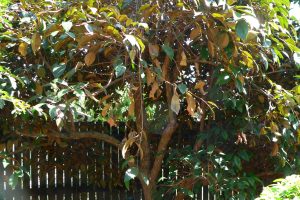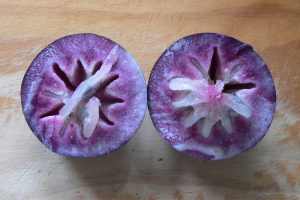Chrysophyllum cainito
Star apple, caimito
Origin
Southern meso-America. Initial domestication likely occurred in Panama, and it is now grown in many warm climate regions of the world.
Climate
Best adapted to hot and humid tropical climates up to 1000m with a definite dry season. Temperatures of 4°C and below will cause defoliation and then more severe damage and death.
Plant Description
An ornamental tropical tree up to 20m tall, less in cultivation, with scaly brown bark and a dense crown. It is evergreen in the tropics but semi-deciduous in cooler climates. The simple entire alternate distichous oblong-elliptic leaves, 6-15 x 3-5cm, with a 1-2cm petiole are glossy green on the upper side and golden brown underneath. There is a substantial taproot and copious gummy white latex is exuded with injuries.
Relatives
A member of the Sapotaceae Family, with the genus Chrysophyllum currently (2021) having 52 accepted species. Other fruiting species in the family include mamey sapote, green sapote, canistel, abiu, lucuma and sapodilla.
Soils
The tree is not particular as to soil, but it needs good drainage and prefers slight acidity.
Propagation
Mostly by seeds which don’t come true to type. Best results are obtained if sown within a month of collection, but if kept dry will remain viable for a few months. They should first be scarified (sandpaper) then soaked in water for 24 hours. Germination is epigeal and at ambient temperature may take 25-50 days with success rates up to 80-90% possible. The seedlings are phanerocotylar. Mature wood cuttings are easy to strike, and tip cuttings can be rooted under mist. Marcots can be produced in 4-7 months and resulting plants will bear early. Budded or self-grafted trees can sometimes fruit within a year of being set in-ground, and selected Caimito varieties can be inarched on star apple seedlings.
Cultivars
Caimito is a semi-domesticated fruit and the few named varieties come from wild selections rather than breeding; some available in Australia are Haitian, Grimal and Pink. Breeding goals would be to improve cold tolerance, dwarfing, increase fruit pulp proportion, reduce the juvenility period and increase storage life.
Flowering and Pollination
Ramiflorous or cauliflorous axillary inflorescences are fascicles on current season’s growth, with 5-20 tightly bunched small flowers that can be green, cream-white or purple on 0.5-1cm pedicels. The slightly unpleasant smelling flowers with petal osmophores are morphologically hermaphrodite with 4-6 sepals and a tubular 5-lobed 3-4mm long corolla; lobes are about the same length as the tube. There are 5-6 stamens, 1-1.5mm long, inserted at the top of the tube or the base of the lobes; staminodes are usually absent. The ovoid-globose superior ovary has 8-10 locules that each contain a single ovule. Flowering occurs in late summer to early autumn. Anthesis of 2-3 flowers in an inflorescence occurs early each day and stigmas may become receptive some hours later. There has been little work done on sexual reproduction in this neotropical genus, with some species being structurally hermaphrodite, dioecious, monoecious, andromonoecious and polygamous. Functional behaviour may not conform with these processes for a number of reasons, eg dichogamy, genetic self-incompatibility or pollen sterility. Molecular genetic studies have revealed the norm in neotropical trees is facultative xenogamy, and cryptic gynomonoecy has been reported for C marginatum, a taxonomically close relative of cainito. Many insects visit the flowers to gather pollen and nectar, but bees and flies are the main pollinators.
Cultivation
Young trees should be watered at least weekly. Irrigation during and after the flowering period will improve yield. They can survive without any fertiliser but productivity is improved, particularly in limestone and other infertile soils, if NPK is given from a young age, increasing to 3kg/tree/year as they mature.
Wind Tolerance
Poor, needs shelter from wind.
Pruning
Early pruning involves selection of 3-4 main branches to establish a balanced scaffold, and dead or crossing branches should be removed. Tree size should be contained when mature.
The Fruit
Fruit are smooth-skinned apple-sized berries (average 100g but up to 250; the more seeds the bigger), almost spherical, surrounded with a leathery skin that comes in two types when mature, green and purple. Generally the purple-skinned varieties have better flavour but are slightly smaller. The sweet and jelly-like flesh is generally white to creamy-white depending on type and contains on average 5-6 (rarely none) shiny elliptic laterally compressed adaxial smooth dark brown seeds, 0.5-1.5cm long, 5-6g, with a white seed scar (hilum) almost the length of the seed. The common name star fruit derives from the pattern seen when the fruit is cut transversely. It has no outstanding nutritional properties apart from good polyphenol antioxidant levels. Flesh carbohydrate content, mainly glucose, is normally about 15% but up to 28%.
Fruit Production and Harvesting
Seedlings may take up to 15 years to progress from the juvenility period (some may never fruit), but this can be reduced to less than 4-5 with grafting. Fruit mature in a staged fashion about 180 days after fruit set, and they are generally in season from late winter or early spring to early summer. Fruit don’t fall when ripe and should be hand-picked with a slight stem remaining when soft to the touch and skin is slightly dull and wrinkled. They are non-climacteric and if picked too early will be gummy, astringent and unpalatable. Over-ripe fruit that fall will likely be damaged. Well-managed mature trees can produce more than 100kg fruit, and ripe fruits will last about 3 weeks in a refrigerator.
Fruit Uses
Fruit are mainly consumed fresh (or chilled) when perfectly ripe by cutting in half and then spooning out the flesh which is about 50-60% of the whole fruit. The skin, rind and seeds should not be eaten. Fresh pulp can also be processed in various ways eg juices and jellies.
Pests and Diseases
Medfly can be a problem despite the tough pericarp, fungal infections, stem-end decay, leaf spots and birds.
Comments
This tree could be grown purely for its attractiveness. Seedlings are really only of value as rootstocks. One of the tropical exotics rarely seen in WA.


